Metal ion-exchanged zeolites as highly active solid acid catalysts for the green synthesis of glycerol carbonate from glycerol
Abstract
The application of metal ion-exchanged zeolites as highly efficient catalysts for the synthesis of glycerol carbonate from glycerol carbonylation is reported. The catalysts were prepared by an ion exchange method and characterized by XRD, py-FTIR, AAS, NH3TPD, N2 sorption and SEM. The Na, H and Zn forms of different zeolites were screened for the reaction. The Zn-FAU zeolite exhibited a high glycerol carbonate yield compared to other Zn-zeolites such as Zn-ZSM5, Zn-MOR and Zn-beta. The acidity of the Zn-HY zeolite was correlated with the amount of zinc and catalytic activity of the reaction. As the zinc content increased in HY zeolite, glycerol conversion and selectivity for glycerol carbonate increased due to an increase in Lewis acidity. Among different metal ion-exchanged HY zeolites, Zn2+ showed a higher catalytic performance. Zn-Y catalyst with 0.79 mmol g−1 of zinc content gave 94.6% glycerol conversion with 98% selectivity for glycerol carbonate. The degree of zinc loading, reaction temperature, catalyst amount, mole ratio and catalyst reusability were investigated.


 Please wait while we load your content...
Please wait while we load your content...